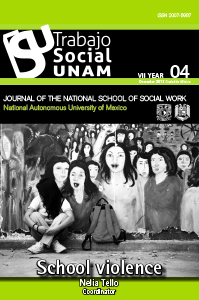School violence in the classroom: reflections on its causes, consequences and social links
Contenido principal del artículo
Resumen
School violence is a global phenomenon which causes great social
unrest. A broad theoretical debate has been going on for the last
few decades along with extensive research in various fields: education,
social work, social psychology and sociology, etc., which gives us reasons to believe that we are facing a multidimensional, transversal social problem, whose significance goes beyond its basic context: school and education.
This article makes a theoretical review of various contributions, mentioning its causes and consequences, stressing the ties established between family and the socio-cultural environment. In this regard, it must not be forgotten that school violence falls within different levels; from school itself to society. This concern, obviously, increases the variety of approaches, results and ways of dealing with it.
School violence is a complex and dynamic social phenomenon, which is gradually changing and it does so at different rates depending on the society in which it is framed. But they all have in common the negative results of this process for individuals, education and society as a whole.
In this article we will essentially focus on peer violence. There are plenty of other types of school violence, although attacks among students are one of the most shocking for society. At the same time, this kind of violence is also one of the least visible, the most silenced and even the most accepted and justified.
unrest. A broad theoretical debate has been going on for the last
few decades along with extensive research in various fields: education,
social work, social psychology and sociology, etc., which gives us reasons to believe that we are facing a multidimensional, transversal social problem, whose significance goes beyond its basic context: school and education.
This article makes a theoretical review of various contributions, mentioning its causes and consequences, stressing the ties established between family and the socio-cultural environment. In this regard, it must not be forgotten that school violence falls within different levels; from school itself to society. This concern, obviously, increases the variety of approaches, results and ways of dealing with it.
School violence is a complex and dynamic social phenomenon, which is gradually changing and it does so at different rates depending on the society in which it is framed. But they all have in common the negative results of this process for individuals, education and society as a whole.
In this article we will essentially focus on peer violence. There are plenty of other types of school violence, although attacks among students are one of the most shocking for society. At the same time, this kind of violence is also one of the least visible, the most silenced and even the most accepted and justified.
Detalles del artículo
Cómo citar
Fernández-García, T., & Andrés-Cabello, S. (2016). School violence in the classroom: reflections on its causes, consequences and social links. Trabajo Social UNAM, (4), 97–112. https://doi.org/10.22201/ents.20075987p.2013.4.54441
